29th of August 2019 – At 5:00 in the morning I am wide awake and decide to continue my hike. Sadly, I did not have access to electricity, so I need to be a bit more careful with my phone use. Thankfully, I have a power bank which will serve as back-up power. Around half past five the sun rises, and I take a few nice pictures of the surroundings from the gate house. Lets rise to the challenge of a day walking and bathing!
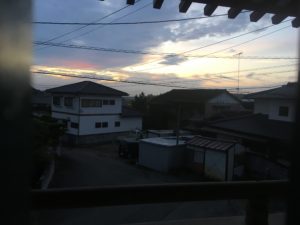
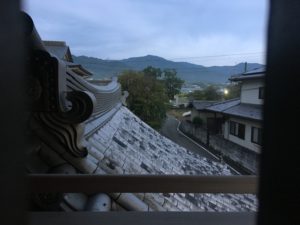
From temple 6 to temple 8
I can skip temple seven, because I had gone there the day before. So, I will need to walk about 5.6 kilometres to temple eight, Kumadan-ji. Tonight, I want to sleep at a bath house, an onsen. They offer pilgrims a free place to rest; zenkonyado. I am curious to see if that can work for me. Yesterday I called them and tried to reserve a place in my best Japanese. They made it clear that apparently, they don’t accept those.
But first, today’s route. It leads me out of the city, featuring more and more small patches of forest and farmland. As I go, it becomes calmer. It is beautiful to see how the landscape changes.

Somewhere around eight I approach a small body of water. In its middle, there is a shrine. Via a small bridge I should be able to reach it, but I don’t dare to. Instead, I elect to take a picture.

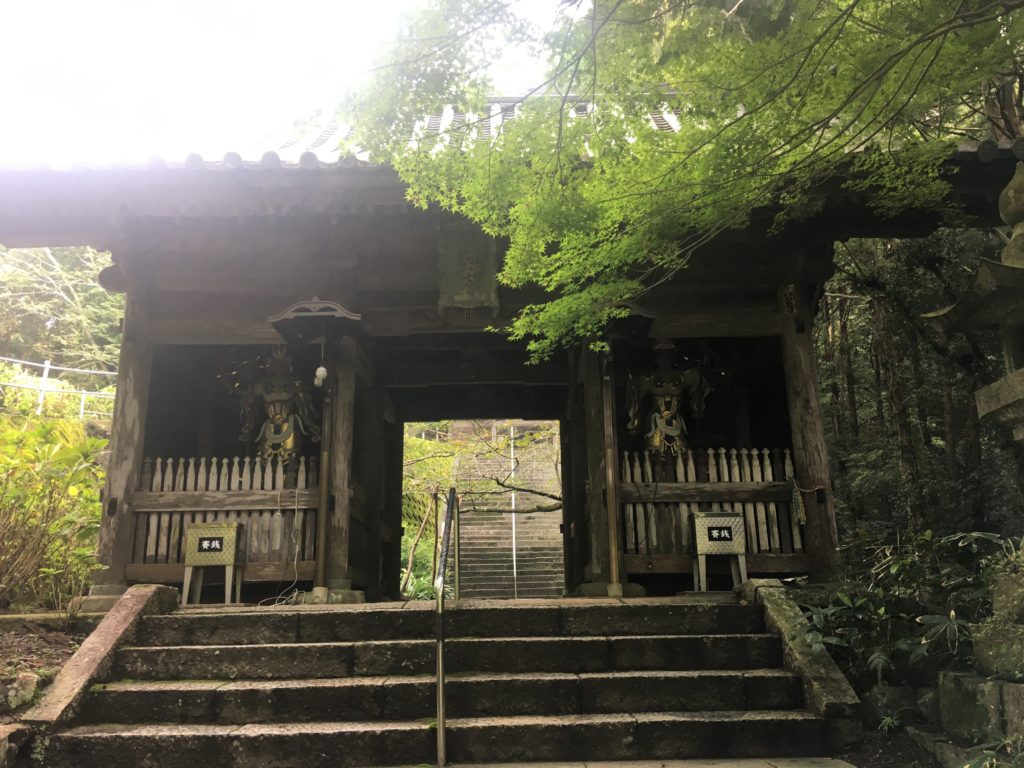
Temple 8 – Kumadan-ji
Temple 8’s gate, the temple called Kumadan-ji, is masterfully carved from wood. It emanates peace and decency. The road to the temple itself is rimmed with pillars made from natural rocks which have chants written on them. This frames the path beautifully. Inside the temple, I perform my ritual.

The monk inside the temple asks me where I am from in English. We come to a conversation, and he asks me what I have been drinking. I show him my camel bag and tell him that I have been drinking water. He warns me that I, other than water, also need nutrients. Interspersing sports drinks with my water couldn’t hurt. As osettai, he gives me a can of Aquarius. Delicious and ice cold! Even if it’s just because of that, I will be taking his advice.
From temple 8 to temple 9
The route to temple nine is short; 2.4 km. I reach it in not even half an hour. At least… that is when I pass through the gate house. The gate is quite far removed from the actual temple. I first need to hike down a path and cross a road before I reach the temple itself.

Temple 9 – Hoorin-ji
The temple, Hoorin-ji, itself, lies on the corner of two roads. There is a parking lot where a bus is stood. The bus is full of pilgrims that are being driven from temple to temple. In front of the temple, there is an udon shop. I don’t feel comfortable entering yet. I don’t know what I would have to do, how I would order anything. My fear of the unknown is stopping me.
So, I enter the temple, and it is time for my ritual and a bit of rest. I put my backpack next to the gate house on a bench, go to wash my hands and mouth, and leave to visit both altars. My ritual is slowly becoming mine. I softly pronounce the heart sutra. When I finish, I seat myself on a bench and take some rest. It is still early, and around quarter past nine I exit the temple.
From temple 9 to temple 10
The route leads me 3.9 km further to temple ten. I reach it after forty-five minutes. An exit to the right on the road sends me down a street teeming with little temple shops. This is where you can buy the pilgrim outfit, incense, candles, and all sorts of other temple things. Apparently, this is the starting place of plenty of henro. The last meters of the road lead you up towards the parking lot of temple ten.
Temple 10 Kirihata-ji
Kirihata-ji lies one the edge of a mountain. The road leading up is made up of mostly stairs. Halfway up the stairs, I realize that I will also have to descend these same stairs when going down the. I decide to leave my backpack somewhere halfway up the trail next to a small temple building. My trust in Japanese people and mainly other pilgrims has grown over the past few days. Japan is a very secure and safe country, and a pilgrim’s belongings… they are untouchable!
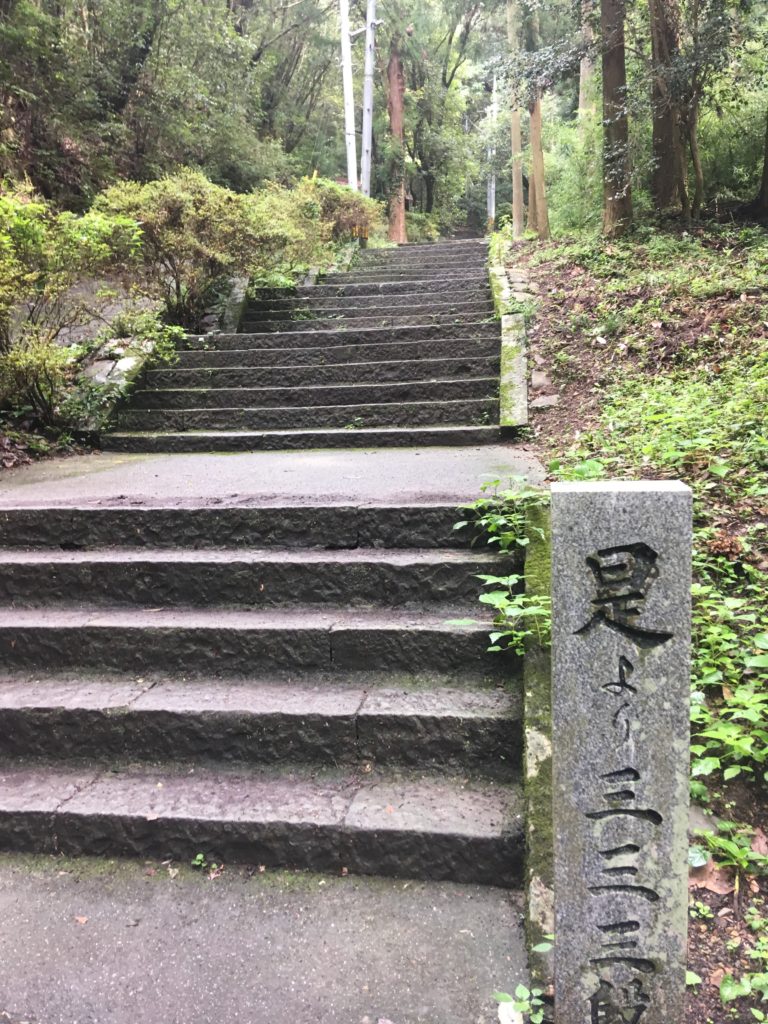
Hiking up the hill without a backpack saves me a lot of effort. It’s almost eleven kilograms that I don’t have to carry. And that makes a world of difference on those stairs. With just my temple bag, I continue. I ascend a few more flights of stairs to get to the temple itself, because the altars are at an elevation of 155 meters. There is a road next to the stairs. Pillars of natural rock with chants separate the road from the stairs.
The temple itself is cosy, despite its spaciousness interior. I look for the main altar, recite my sutra’s, and repeat them at the daishi-altar. The rhythm is finally sinking in. Time to retrieve my stamps, and then I’ll be on my way back to my backpack.
Meeting a Dutch henro along the trail!
On my way down, a blonde lady comes my way. We simultaneously begin speaking in English. Then it turns out that she is Dutch and is called Geertje. Fun to get to know each other for a little bit, we give each other our osamefudo as if we are experienced pilgrims. On the slip of paper, I find her email address. She mentions on Facebook that she is a member of a group about the henro. I should look at that when I have time this evening. After a short conversation we each go our separate ways. Around half past ten I put my backpack back on and leave temple ten behind me.
From temple 10 to temple 11
The route guide gives two ways to walk to the next temple. I decide to take the shorter route of 9.7 kilometres, which leads me over a small bridge. The alternative is to walk next to a large road and over a big bridge. This is a longer trek and seems much less attractive. The route I chose ends up being gorgeous. I do notice that the heat and the weight of my backpack are taking their toll. My feet are tired. I am not used to the hot and humid air, and the weight of my backpack presses against my back and makes my steps heavier.
In 2024 I revisited the area and walked the big bridge. It rained and was windy so the walk on the bridge seemed endless. On the positive side: there are some Konbini along that trail to temple 11! And following this trail will take you to Oyado Eleven (Henro no stao) a place to rest and/ or stay the night (available as of 2024).
A short break
I take a break at a henro-hut. I take off my shoes and socks and check my feet. It turns out to have gotten a blister. This also happened to me earlier this year at the Four Days March of Nijmegen, but only on day four. After piercing my blister I put on clean and dry socks. I hang the wet socks on my backpack, next to those from two days ago. I had washed those by hand and because of the wet air they still hadn’t dried. This evening, I will have to do something about that, because otherwise I will not have any clean socks for tomorrow! A little rested and refreshed, I stand back up, put on my backpack, check if I haven’t forgotten anything, and continue my trek.

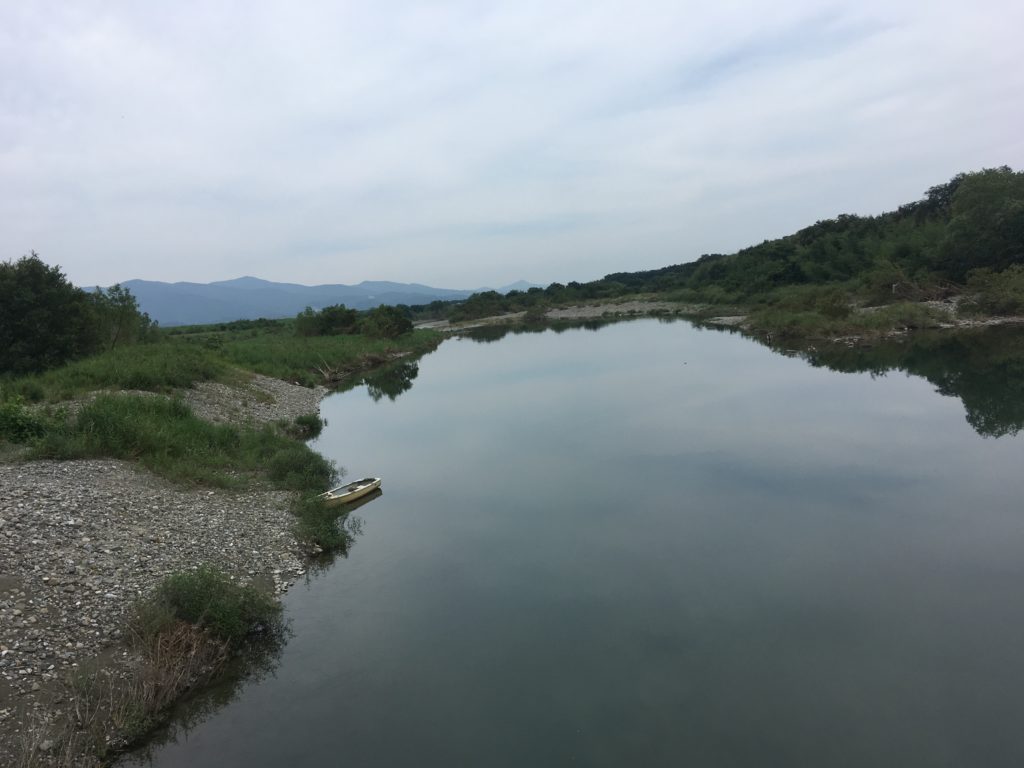
A river and a dyke
The path goes over the Onojima and Kawashima bridge. It is funny to see that the rivers here have dykes; it almost looks Dutch! The deltas are wide, I can see that a lot of debris has been dragged along with the water. Rubbish, trees, and branches are stuck under the bridge, and are spread out over the floodplains. The second bridge is pretty risky. It is a stretch of concrete the width of one car. On two places the bridge has been widened, so that I can stand to the side if there is a passing car. I need to step away twice. It is quite busy for such a small bridge.

An unexpected meet-up
When I climb the dyke on the other side of the river, a Japanese man calls for me. He has parked his car on the path. I approach him and greet him; o-hayo gozaimasu! He turns out to be a pensioner from Tokyo who looks kindly upon pilgrims. He speaks some English, and with my Japanese as back-up we can speak for a little while. He tells me that he has been to Amsterdam before for his job as an engineer, and as a result knows the Netherlands somewhat. Every year he escapes the summer heat of Tokyo by going to Shikoku. Tokyo must be extremely hot if he considers 34 degrees and 90% humidity a better alternative. He gives me a little cake as ossetai and I give him my osamefudo.

Already on page four of my Route Guide-maps!
After passing the river, I reach the fourth map of the booklet. This gives me the feeling that I am finally getting somewhere! The route to temple eleven is quite beautiful, taking me past rice fields and a smattering of buildings.
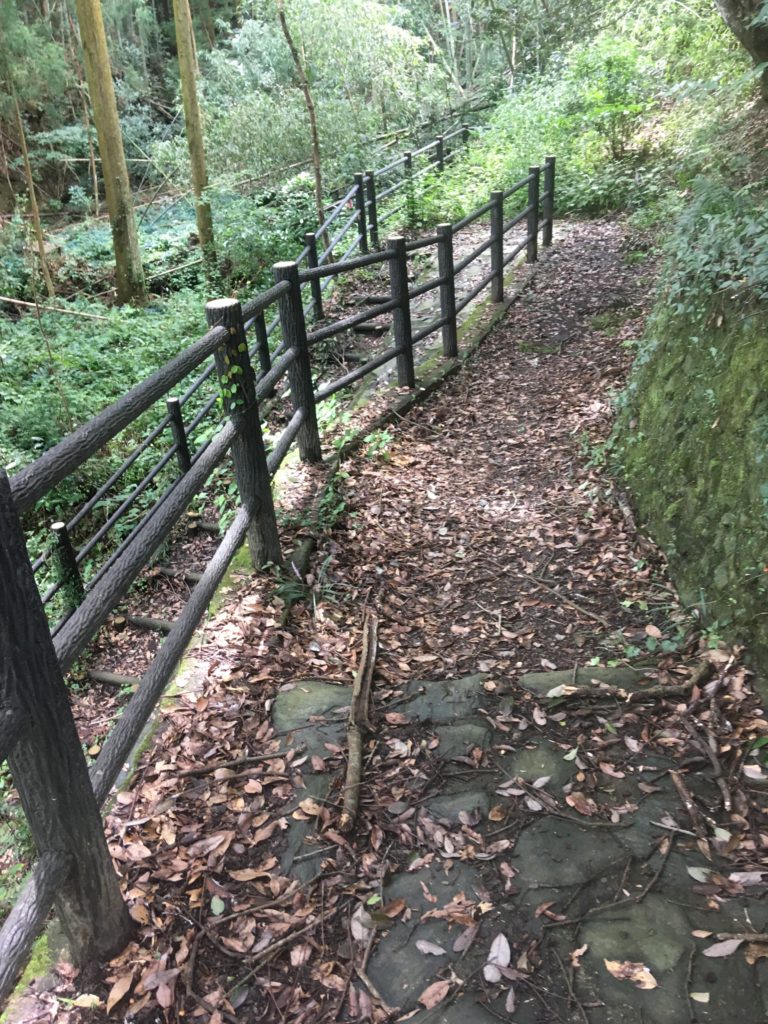
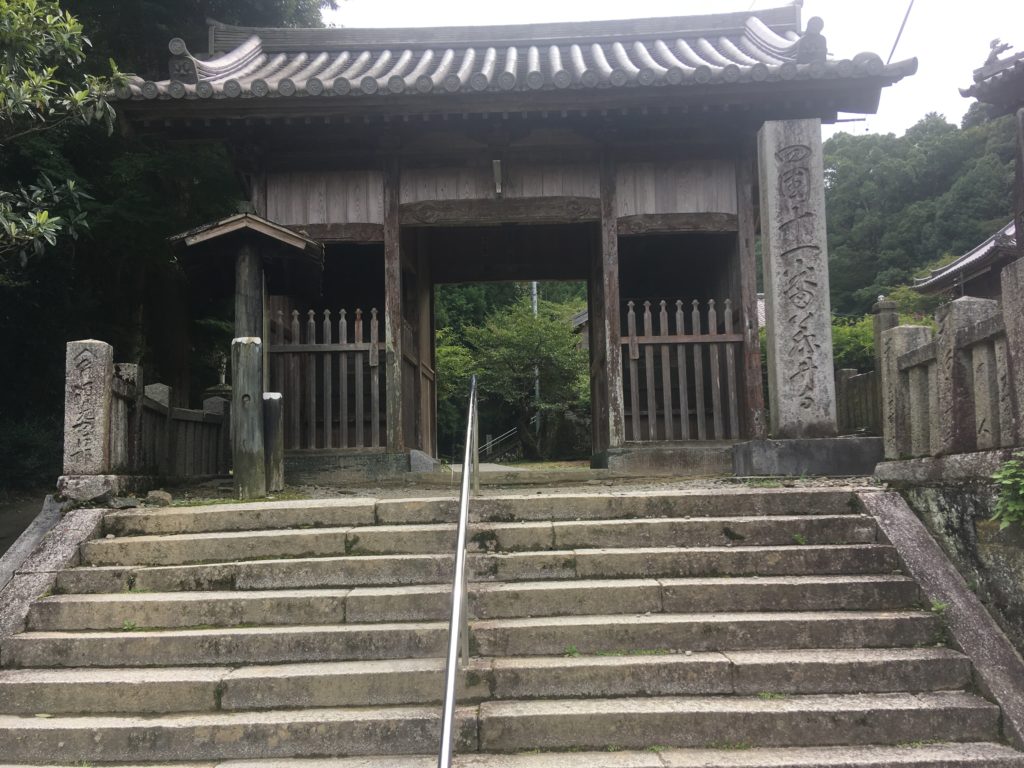
Temple 11 – Fujidera-ji
Around half past one I reach temple eleven, Fujidera-ji. It is a special temple. The location is a little above the city, and a steep and narrow path leads to the temple. Accessing this temple requires some detective work. Luckily the main altar is easy to locate, but I cannot see where the daishi-dou is. With some looking around, I manage to find the daishi-dou, thankfully. This allows me to also do my second ritual.
Arraging tomorrow nights’ stay
At the nokyocho-office, I ask them what a good place would be to sleep after I reach temple twelve. I had hoped for a French-sounding Minshoku; Morians Loft. It turns out to not be open. The alternative, Sudachi-an, is also closed. It is very early on in the season, which means that there are not a lot of pilgrims, and many of the mainstay’s owners are still enjoying their rest; they’re still on holiday.
Luckily, ryokan Nabeiwa-so has a spot for me. It costs ¥ 7.000,00. That does include two full meals. Because I was able to sleep for free in my past two nights’ accommodation, that should be no issue. And after tomorrow, I deserve to be treated a bit; temple twelve lies very high up. You first ascend a mountain of 800 metres, then you descend again to 600 metres, and climb to another 800 metres. I hope I will be able to survive that challenge!
Walking and bathing: finding my place to sleep
After receiving my stamps, I walk out of the temple at a leisurely pace and look for the way back to the city. I want to stay at the onsen Kamono-yu for the night. According to the map and web blogs of other pilgrims, they have a hut next to the onsen which serves as adequate accommodation, with no fee, just a contribution for the use. Luckily, the way to the onsen is quite easy to find. Along the way, I notice how tired I am. Finding out how far I have left to go takes a lot out of me. In the end I ask a passerby on a bike in my best Japanese. She tells me that I am almost there and tells me to continue for a bit longer along the road I was already on.
After the periode of COVID-restrictions most of the zenkonyado (free places to stay), have been closed. Unformtunately the place I stayed doesn’t provide a sleeping spot anymore. The onsen (bathinh facilities) however are still available and I recommend a visit to them if you stay at an inn nearby.
Bathing and sleeping at Kamono-yu onsen
At the onsen I present myself at the reception. The lady at the desk sets off on an entire narrative in Japanese. I pick up that I may sleep in the hut, will receive a discount on the onsen, but will need to take care of my own food. She guides me to a waiting room where I can retrieve hot and chilled drinks from a vending machine in the comfort of an airconditioned room. I am dehydrated and hot, so I open my wallet to purchase two bottles of Aquarius and rehydrate. After that, I head out again.
First doing my laundry
The hut is in the direct heat of the sun and is boiling hot. I’m thankful that the windows can open. That’s a windfall, because that means that there is some ventilation. Next to the hut there is a washing machine and a dryer. In the vending machine inside the onsen I buy some laundry detergent. With that, I wash my clothes and put most of them in the dryer (except for my socks). Luckily, those did go through the centrifuge cycle, which saves drying time. I hang my laundry in the open window, but of course I am not allowed to do that! One of the ladies from the onsen immediately heads over to ensure that I hang my laundry inside. Due to the high humidity and no wind inside, it takes exceedingly long to dry.
Walking and bathing: a visit to the onsen
Now I am ready for a shower or at the very least some washing up. I enter the building of the onsen. I need to purchase a ticket of entry at a terminal/ vending machine. Then I put my shoes inside a small cupboard, from which I retrieve a pair of slippers. I bring the key to the cupboard back to the front desk, and then the lady sends me inside past the blue curtains. She tells me; blue is for gentlemen; pink is for ladies; that is how things work in Japan.
Through a door I enter the gents’ changing room. I am immediately greeted by the sight of a group of naked Japanese men. I look for my locker (with the same number as my cupboard out front), take off my clothes, and put my things inside. Now naked, I go to the washing room, only carrying a small towel. Sitting on what appears to be a reversed bucket on the floor, I take the showerhead, rinse myself off, and soap my body. Then, I wash off the soap and repeat the process. I follow the others’ example. Now fully clean, I can enter the baths. First, I should feel out which ones are hot, and which cold. The first one I approach is fine, around 40 degrees.
A row of four men in the nude
I quickly make contact. One of the men comes over to sit next to me and strikes up a whole conversation in Japanese. I barely understand a word of it. I’m glad I know a few basic sentences. I tell him that I am a walking pilgrim; ‘aruite henro desu.’ This information is received with admiring mumbling. Two more men join us. They want to know where I am from; ‘Orandajin desu,’ I am from the Netherlands. Again, mumbling, and I think I hear them say that two of them are from Awa, and one from Tokyo. The first gentlemen proceeds to ask me if I also think it is too hot; ‘atsui desu, ne?’ I can affirm that; ‘hai, atsui desu, yo!’
Apparently with that, I passed their test, because all three of them proceed to speak to me as if I have been in this bath with them for years. I understand that they are talking about the weather, have never completed the pilgrimage themselves, and that they think it is special that I want to do the entire journey in one go, while walking. One of them takes me with him to explain what baths I should take, and in what order.
Walking takes a lot of energy
After an extensive tour I am as red as a lobster and all drowsy. I take a shower sitting on the little ‘stool’ again, dry myself off with my towel, and weigh myself. The result shocks me: I have lost about four kilograms in the time that I have been here. It is urgent to do something about that. I put my clothes back on, feeling fortified, both mentally, and physically. On my way outside, I greet the ladies at the front desk. They give me an additional warning: I am not allowed to cook inside the hut!
Taking in English with a Japanese lady-henro
I make use of the fact that I have become sleepy from the bathing, and I have a nap. When I wake up, another pilgrim has arrived; a Japanese lady. We get to know each other, and thankfully she speaks English quite well. We talk a little, after which she departs to the second hut, which is reserved for women, and checks it out. Then she goes to look for dinner. I decide to follow her example and saunter over to the nearest konbini. There, I buy food for the evening and tomorrow. Tonight, I’m having a double portion; a meal with pasta and rice. I need to take care that I have the energy to complete tomorrow’s climb.
Two Spanish henro: walking and bathing too
When I return, two Spanish pilgrims have just arrived. A lady and a gentleman from Barcelona. She did her PhD in the United States and is now trekking through Asia. He is an old secondary school friend and needed a break. He quit his job as a physical therapist and joined her in Japan. When they heard about the Shikoku88, they thought it would be fun to walk the route.
We quickly get to talking. The Japanese woman returns, retrieves her things, and departs for a sleeping location somewhere else in the city. I exchange information with the Spaniards. I give them some tips, show them my ‘Route Guide,’ and I give them a copy of the list of free sleeping spots that was given to me at Henro House Ichiban.
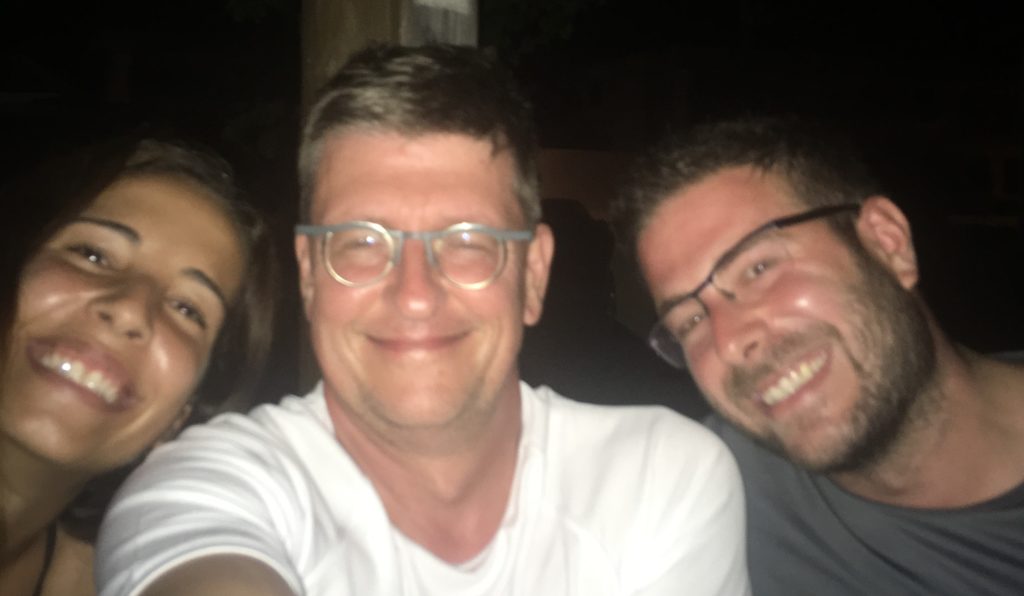
A Japanese henro with priveliges
When it is beginning to get dark, a Japanese man arrives. He deliberates with the ladies at the onsen, and is granted the bike shed to sleep in. He starts cooking his rice on a small gas burner! We don’t manage to establish contact with him.
When night falls, I seek refuge in my sleeping bag. I have all my things ready to depart quickly in the morning. I want to start the ascent as refreshed as possible.
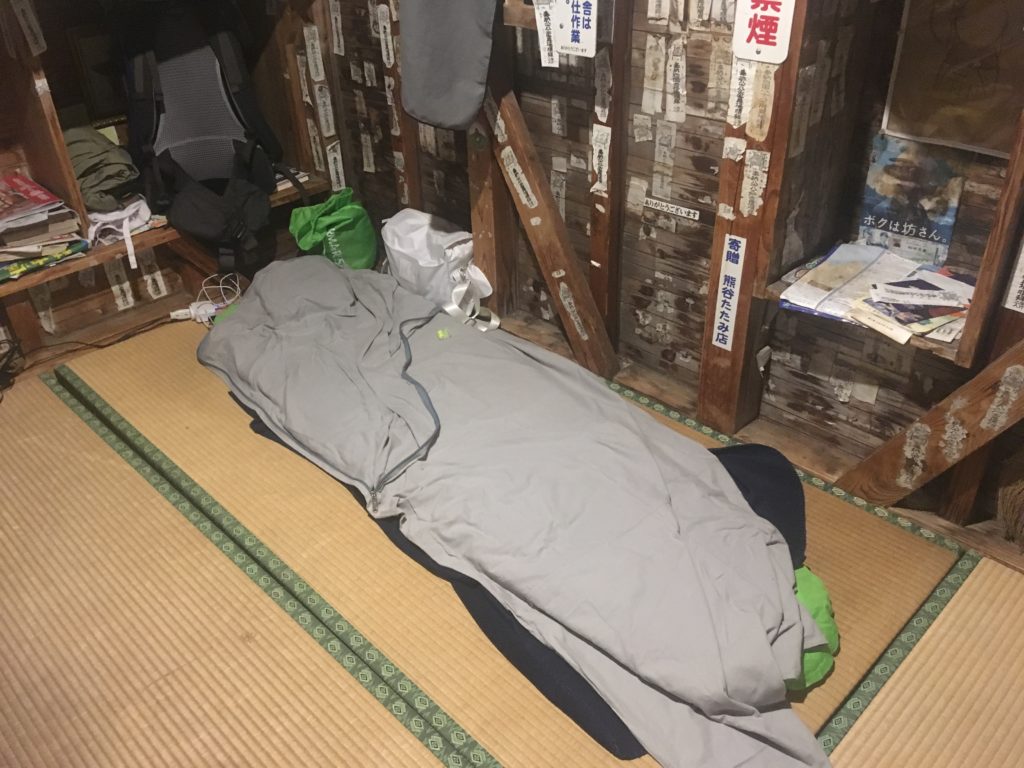
Hiking distance today was 23.8 km.

One reply on “Day 4 – Walking and bathing at an onsen”
[…] a small bench I makes small talk with the Spaniards. He is called Xavi. Sadly, I do not remember her name. We do exchange WhatsApp contact information; maybe we will meet again. Around us the people in the […]